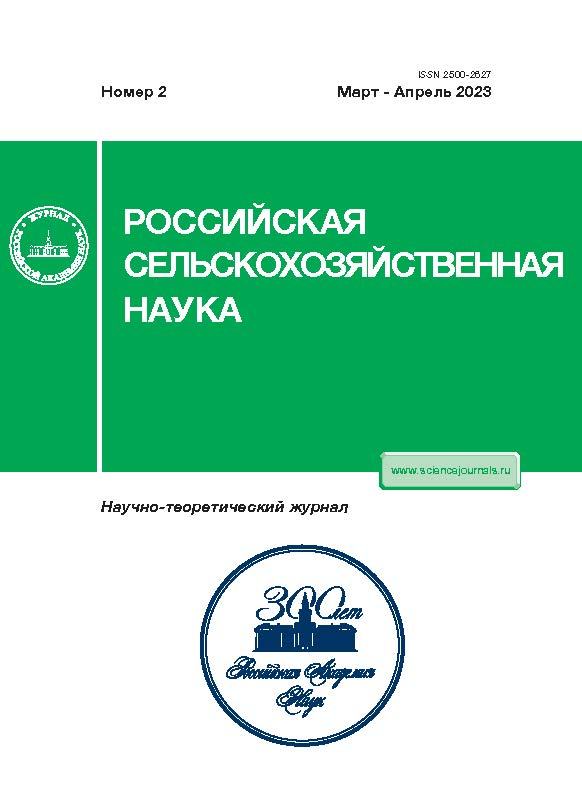On the impact of modern climate change on the increase of grain yields in Russia
- Authors: Savin I.Y.1,2
-
Affiliations:
- Federal Research Center �Dokuchaev Soil Science Institute�
- Peoples' Friendship University of Russia
- Issue: No 2 (2023)
- Pages: 58-62
- Section: Articles
- URL: https://journals.eco-vector.com/2500-2627/article/view/657865
- DOI: https://doi.org/10.31857/S2500262723020126
- EDN: https://elibrary.ru/AQHANQ
- ID: 657865
Cite item
Abstract
In recent years, Russia has seen a steady increase in grain crop yields. A positive trend in meteorological conditions is often considered as the reason for this phenomenon, but there is almost no strong scientific evidence for it. The aim of investigation was to analyze changes in the potential (climatic) grain yields in the country for the period from 2000 to 2022. For this purpose, the simulation model of plant growth WOFOST was used, which allows assessing the impact of all meteorological parameters in a comprehensive manner. The assessment was carried out for a network of representative points (42 points) in different regions of the country for grain crops, taking into account daily meteorological parameters and soil type. Modeling was conducted at the level of potential yield, which takes into account the variation of meteorological parameters only, and it is believed that the limiting influence of other factors on the yield is absent. As a result of the analysis, it was found that the trends of potential yields have different direction in different regions of the country. The trend towards more favorable meteorological conditions for grain crops is observed for the North Caucasus, the lower Volga region, Western Siberia and the Far East, while in the Central and Central Black Earth districts, the upper Volga region, as well as in the south of Central Siberia in recent years there is a drop in the potential yields. The growth of grain yields in recent years agrees well with the trend of changes in agrometeorological conditions in most grain-producing regions of the country. Unidirectional trends in meteorological potential and statistical yields are absent only in the regions of central European Russia, where the role of the climatic factor in grain yield fluctuations is less significant, and where one can assume the effect of measures taken by the government of the country to support and develop agriculture.
About the authors
I. Yu Savin
Federal Research Center �Dokuchaev Soil Science Institute�;Peoples' Friendship University of Russia
Email: savin_iyu@esoil.ru
119017, Moskva, Pyzhevskii per., 7, str. 2b;117198, Moskva, ul. Miklukho-Maklaya, 6
References
- FAO. World Food and Agriculture - Statistical Yearbook 2022. Rome: FAO, 2022. 382 p. doi: 10.4060/ cc2211en.
- Abys C., Skakun S., Becker-Reshef I. The Rise and Volatility of Russian Winter Wheat Production // Environmental Research Communications. 2022. Vol.4. No. 10. 101003. URL: https://iopscience.iop.org/article/10.1088/2515-7620/ac97d2 (дата обращения: 05.02.2023). doi: 10.1088/2515-7620/ac97d2.
- Влияние факторов эффективного плодородия почвы на урожайность и качество зерна яровой пшеницы и их моделирование в условиях умереннозасушливой и колочной степи Алтайского края / И.П. Аверьянова, С.В. Жандарова, А.Б. Совриков и др. // Вестник Алтайского государственного аграрного университета. 2017. № 6. С. 15-20.
- Агроинвестор. Россельхозбанк: за пять лет урожайность зерновых в России выросла на 23%. URL: https://agrarian.expert/rosselhozbank-za-pyat-let- urozhajnost-zernovyh-v-rossii-vyrosla-na-23. (дата обращения: 05.02.2023).
- Сизов А.А. Как изменения климата оказались на руку российским аграриям. URL: https://sber.pro/publication/kak-izmeneniia-klimata-okazalis-na-ruku-rossi- iskim-agrariiam (дата обращения: 05.02.2023).
- Карта распаханности почв России / И.Ю. Савин, В.С. Столбовой, С.А. Аветян и др. // Бюллетень Почвенного института имени В.В. Докучаева. 2018. № 94. С.38-56. doi: 10.19047/0136-1694-2018-94-38-56.
- Столбовой В.С., Молчанов Э.Н. Единый государственный реестр почвенных ресурсов России как модель пространственной организации почвенного покрова // Известия Российской академии наук. Серия географическая. 2015. № 5. С. 135-143.
- Araghi A., Martinez C.J., Olesen J. E. Evaluation of multiple gridded solar radiation data for crop modeling // European Journal of Agronomy. 2022. № 133. Р.126419. doi: 10.1016/j.eja.2021.126419.
- Years of the WOFOST Cropping Systems Model / A. de Wit, H. Boogaard, D. Fumagalli, et al. // Agricultural Systems. 2019. Vol. 168. No. 1. P. 154-167. doi: 10.1016/j.agsy.2018.06.018.
- Савин И.Ю., Столбовой В.С., ван Диепен К. Имитационная модель роста сельскохозяйственных растений WOFOST и ее использование для анализа продуктивности земель России. М.: РАСХН, 2001. 216 с.
- Савин И.Ю., Столбовой В.С., Савицкая Н.В. Климатический потенциал урожайности озимой пшеницы в России // Российская сельскохозяйственная наука. 2017. № 3. С. 17-20.
- Кошкин Е.И., Гусейнов Г.Г. Экологическая физиология сельскохозяйственных культур. М.: РГ-Пресс, 2020. 576 с.
- How good is good enough? Data requirements for reliable crop yield simulations and yield-gap analysis / P. Grassini, L. van Bussel, J. van Wart, et al. // Field Crops Research. 2015. Vol. 177. P. 49-63. doi: 10.1016/j. fcr.2015.03.004.
- Росстат. Методические указания по проведению текущих расчетов объемов производства основных продуктов сельского хозяйства (в натуральном выражении) в хозяйствах всех категорий. М.: Росстат, 2019. 64 с.
- Climate impacts on global agriculture emerge earlier in new generation of climate and crop models / J. Jägermeyr, C. Müller, A.C.Ruane, et al. // Nature Food. 2021. No. 2. P. 873-885. doi: 10.1038/s43016- 021-00400-y.
Supplementary files









